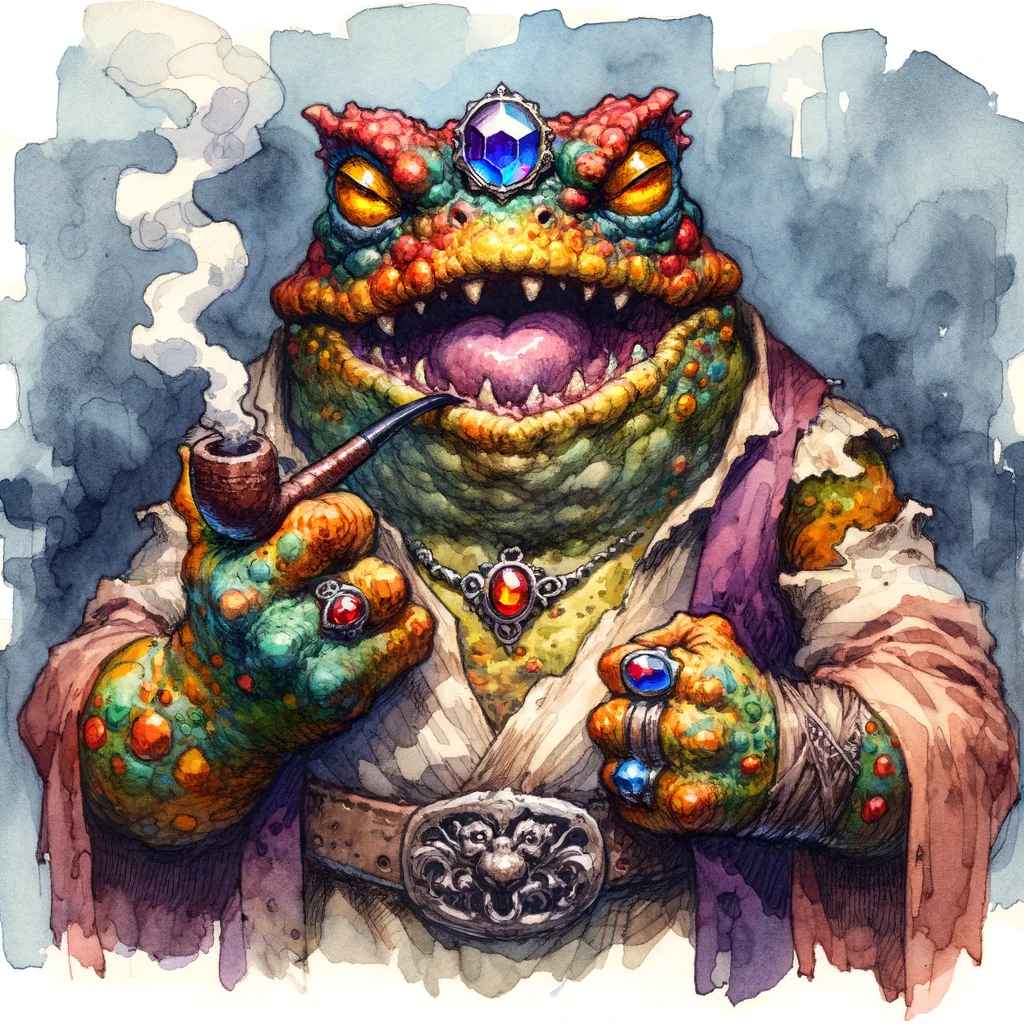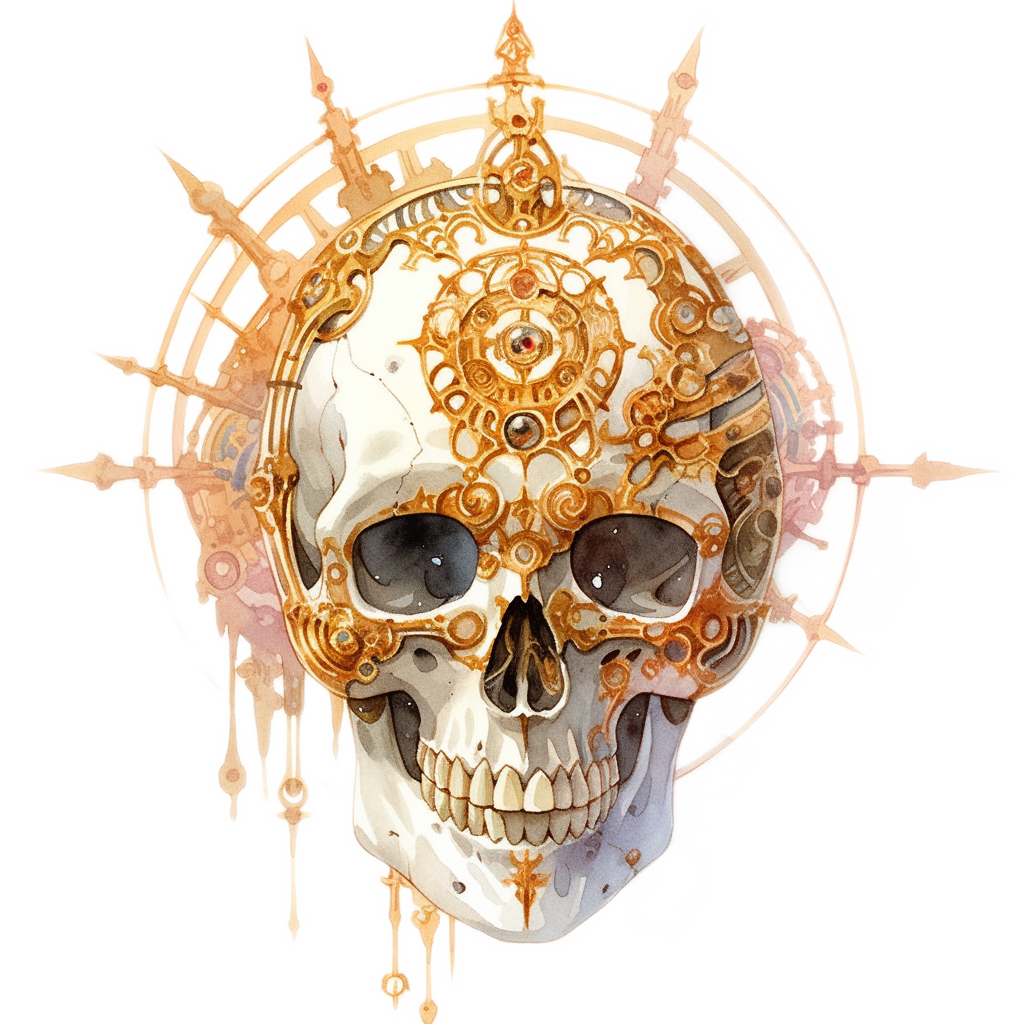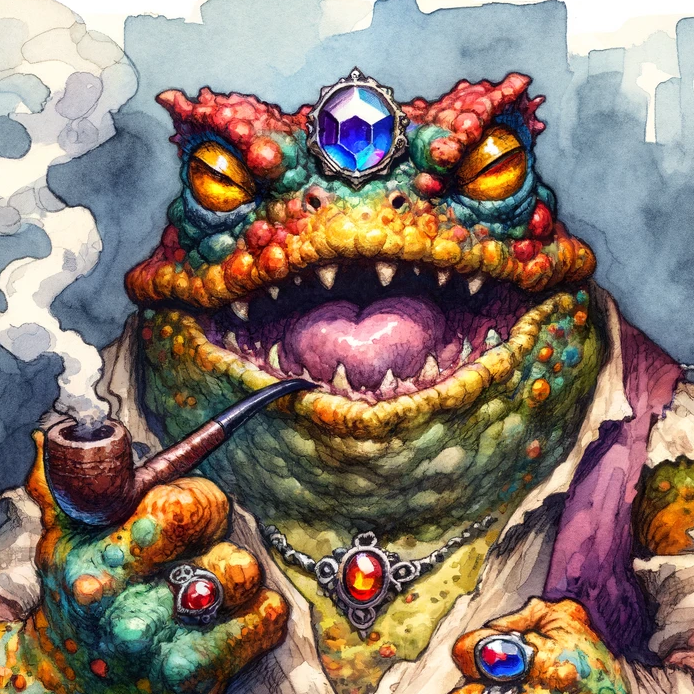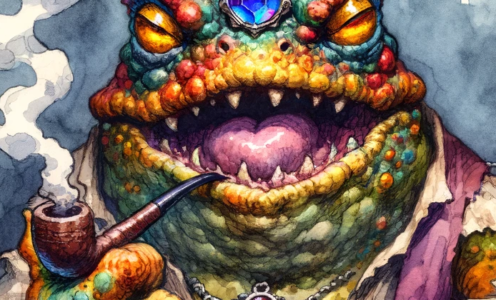Rogue Slaad
| CLIMATE/TERRAIN: | Limbo (any) |
| FREQUENCY: | Very Rare |
| ORGANISATION: | Solitary |
| ACTIVITY CYCLE: | Any |
| DIET: | Carnivore |
| INTELLIGENCE: | High (13-14) |
| TREASURE: | R |
| ALIGNMENT: | Chaotic Neutral |
| NO. APPEARING: | 1 |
| ARMOUR CLASS: | 0 |
| MOVEMENT: | 9 |
| HIT DICE: | 9 + 5 |
| THAC0: | 11 |
| NO. OF ATTACKS: | 3 |
| DAMAGE/ATTACK: | 1d6+2 / 1d6+2 / 2d8 or by weapon |
| SPECIAL ATTACKS: | See below |
| SPECIAL DEFENCES: | +1 or better weapon to hit |
| MAGIC RESISTANCE: | 50% |
| SIZE: | L (7′ tall) |
| MORALE: | Elite (12-14) |
| XP VALUE: | 11,000 |

It’s enough to make an Inner Planar boastful, cutter, but here’s a stark example of the Law of Opposites on the Outer Planes. Even a greenish prime knows there are modrons and rogue modrons, clockwork creatures still obsessed by Law, but with the tiniest sparkle of Chaos inside them. Is is such a surprise, then, to find Rogue Slaad? As the Law of Opposites predicts (and how cross must the slaad be to find even they obey a law!), the rogue slaad are chaotic creatures through and through, but they’re tinged with an essence of law. It’s as if they took a step back from the churning chaos and asked…”but why?” It’s this degree of introspection that sets ’em apart from the rest of the froglike race, too. So how do they appear? It’s easy to imagine a lawful creature affected by a spark of chaos, but the other way around?
Slaadi are ruthless creatures, existing within an pragmatic yet rigid hierarchy. At the bottom lie the red and blue slaadi, then come the green, grey and death slaadi. Though, as a race, the slaadi seek to change the established Planar Order, they are also obsessed with gaining personal power. The more powerful slaadi constantly engage in intrigue and power struggles; the political situation on Limbo is more complex than even a Xaosman can begin to fathom. Green slaadi, being ambitious to become more powerful, will often plot against grey and death slaadi. Sometimes these plots are successful, more often they aren’t. Occasionally a green slaad will be lucky enough to survive but has to flee for its life. It is these fugitives that are called “rogue slaadi”.
Perhaps these slaad have tumbled to a dark about their society and can’t reconcile it with pure chaos, or perhaps they only failed in their bid to advance because they weren’t purely chaotic. Nobody really knows if it’s a cause or an effect, but exist these cutters do, and make no mistake about it. Rarer even than rogue modrons, rogue slaad are still as unpredictable as a barmy Xaositect, most times. But there’s something not quite right about them. If you don’t know many slaad, you probably won’t spot it, but there’s something almost…civilised…about ’em.
Unlike other slaadi, rogue slaadi do not have any tattoos on their foreheads to distinguish station. How these are lost is a mystery, and rogues are always reluctant to talk about the subject. Wise bashers don’t try and press the point. It does deeper than this, though. Rogues aren’t so rapaciously chaotic; they’re more considerate, if that’s possible. Any berk can tell you that you couldn’t sit down at a table and discuss what chaos really is without the slaad eating you. Or the table. But the rogue slaad, well, it’s a different story.
Now that’s not to say you should go putting your head in a rogue’s mouth; that’s just asking for trouble, berk. But take Luzdobog, for example. It’s a rogue slaad often found in the better parts of the Cage (still, no better than the Lower Ward mind, we’re talking relative to the Hive here!) and it’s an amiable enough cutter. You can share a mug of Limboan tea (better believe it’s strong stuff, too!) and a smoke on a foul-smelling howling pipe (it makes an odd noise when you suck in, apparently, not dissimilar to the wind in Pandemonium) with the blood in little fear of your life. Some bashers have mooted the point that the infamous slaad “writer” Xanxost may actually be some sort of rogue rather than a good-natured (if odd) chaotic beast. Who can say, eh?
In any case, rogue slaad are exiles from their native society. Usually green (but sometimes of other colours, particularly a green-grey mixture thought to be somewhere in-between the two ranks), these rogues rarely set foot anywhere near Limbo or Xoas unless they’re on a Mission with a Purpose. Presumably they’re afraid of retribution from their former brothers. Uncannily like modrons, slaad usually try to destroy rogues on sight.
Rogue slaadi speak slaadi and common, as well as a limited form of ESP that allows them to understand and converse with all intelligent creatures.
COMBAT: Rogue slaadi attack with two claws (1d6+2 damage each) and bite (2d8 damage) in their natural form. A rogue slaad can polymorph at will into a duplicate of the human or demi-human that originally spawned it. In their polymorphed humanoid form they attack with any weapons they may be carrying. Rogue slaadi are intelligent, and can use any magical items they happen across. With their might-makes-right attitude, and tendency to grab whatever they want (well, if it works on Limbo…), they’re often endowed with many an enchanted sword, wand or other knickknack.
Rogue slaadi have displayed the following abilities, usable one at a time, once per round, at will: darkness, 15′ radius, delayed blast fireball (once per day), detect invisibility, detect magic, ESP, fear, locate object, produce flame and telekinesis. No individual rogue slaad has shown all these powers, though some learn other wizardly magics, and even (the chant goes), psionics.
HABITAT/SOCIETY: Rogue slaadi are solitary creatures. They actively avoid all other slaadi, fearing retribution for their past wrongs. While the slaad race as a whole isn’t organised enough to actively hunt down or send assassins after rogues, their missing forehead tattoo makes them obvious targets should rogue and non-rogue happen to meet. And if this does occur, the fur (or slime) really starts to fly.
Most rogues are wilderness beasts, found wandering or hiding on far-flung planes. Many dwell forever in isolation, but after a period of self-reflection (or mourning?), some return to more civilised climes to make new lives. It’s these individuals who dwell in cities like Sigil, the Town at the Centre, Faunel or Torch.
ECOLOGY: Some rogue slaadi are obsessed with revenge. They wander the planes, trying to gain followers and power to enable their revenge on the slaadi from whom they are fleeing. Most rogue slaadi prefer their humanoid form for dealing with other races, though this depends on the original host from which they were spawned. It also makes identification of them from the more common slaadi difficult. However, rogue slaadi who were spawned from baatezu or tanar’ri find that members of other races respond better to them in their slaadi form than humanoid.
Others have settled in other areas (even in Sigil) and whilst they can appear established in that area, the desire to return to Limbo to avenge their exile is often their underlying driving force. Several rogue slaad are said to be prominent members of the Pandemonian sect the Dispossessed.
A third group seem content to reflect on the multiverse and just be. This way of thinking has led more than one rogue slaad to join the Ciphers, though the Xaositects are a usual obvious choice. It’s these individuals who’re most at risk from the wrath of pure slaad, who see their apparently pacifistic ways at the most perverted from the usual slaadi ideal. Fortunately for cutters like Luzdobog, these bashers know how to attract powerful allies…
Source: Ben Harris and Jon Winter-Holt



